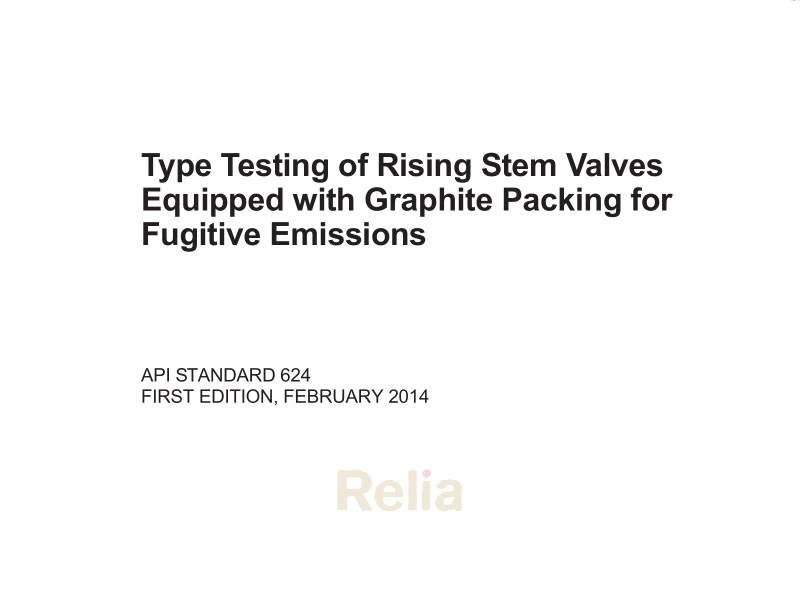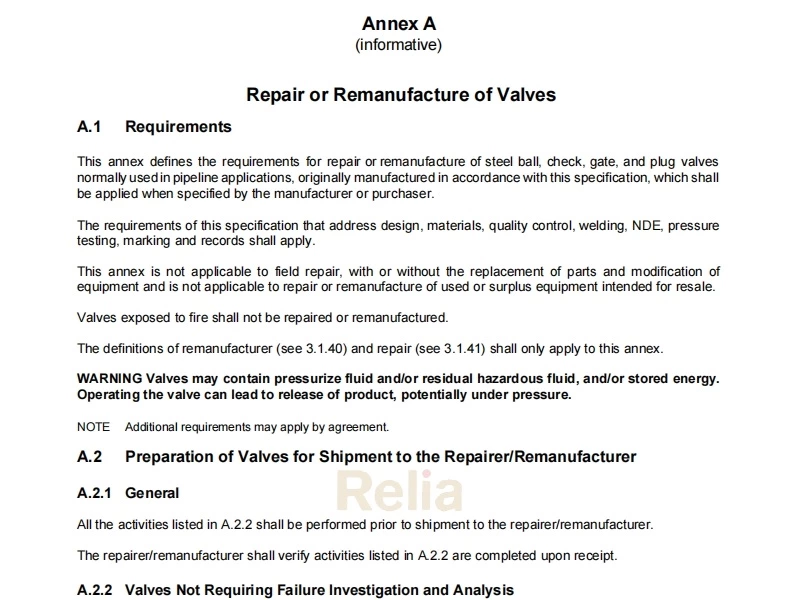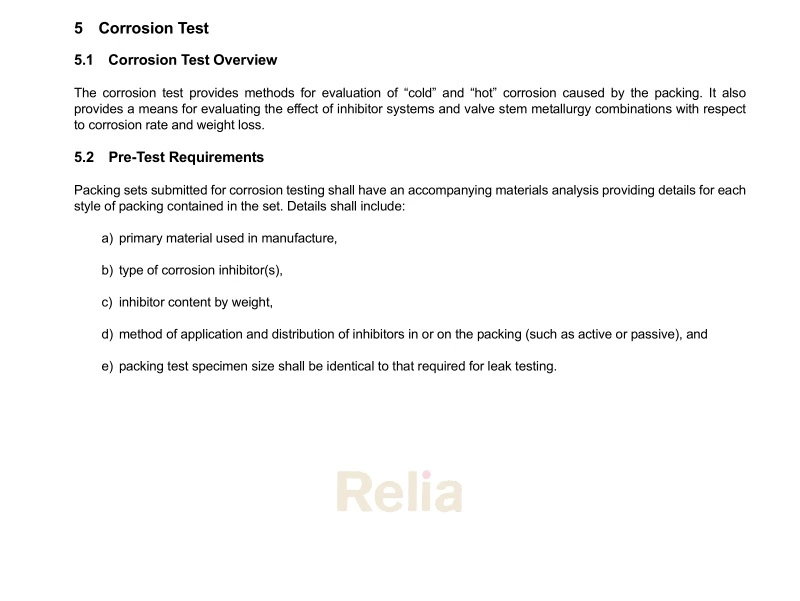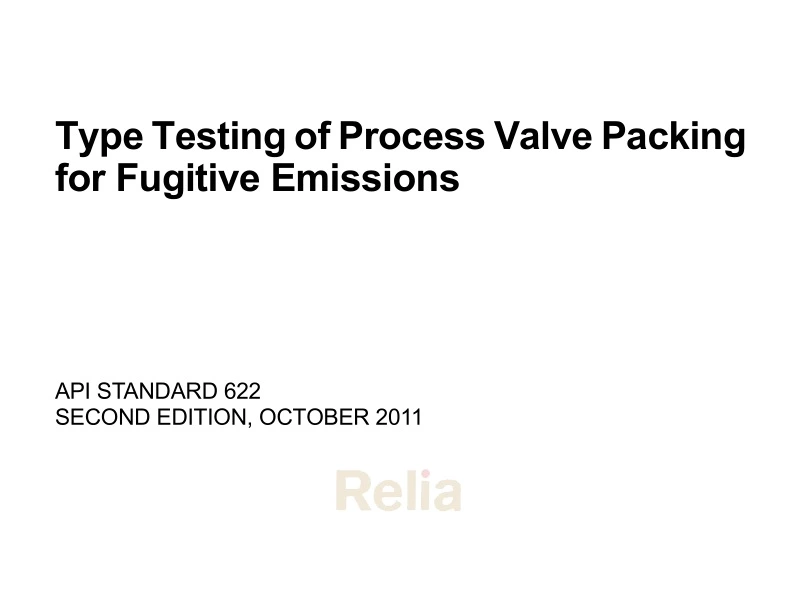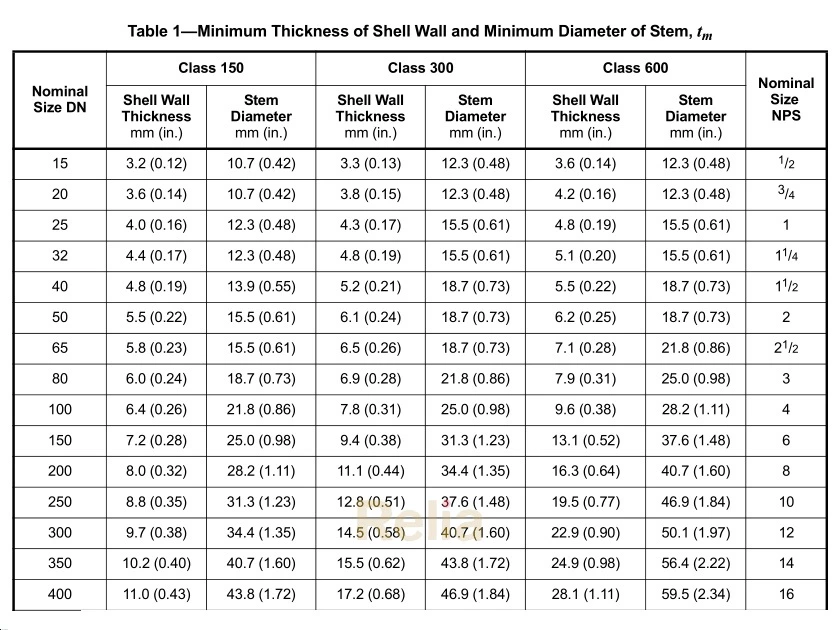API 641:Type Testing of Quarter-turn Valves for Fugitive Emissions
API 641 standard specifies the requirements and acceptance criteria for fugitive emission type testing of quarter- turn valves. The type testing requirements contained herein are based on elements of EPA Method 21.
Valves larger than NPS 24 and valves greater than ASME B16. 34 class 1500 are outside the scope of this standard. Valves with a pressure rating at ambient temperature less than 6. 89 barg(100 psig)are outside the scope of this standard. Repacking or resealing of valves is outside the scope of this standard.
8 Type Testing
8. 1 Testing shall adhere to the requirements below. The testing profile can be found in Annex B.
8. 2 The manufacturershall either engage an independent qualification facility to perform the tests or a third party to witness and certify tests done in their own facility.
8. 3 The stem orientation for a test valveshall be vertical.
8. 4 Valves shall be subjected to a total of 610 mechanical cycles and 3 thermal cycles per Figure 1. Mechanical and thermal cycling shall begin with the valve at ambient temperature.
8. 5 The valveshall be heated using an internal or external heat source such as electric heating blanket, coils, or other suitable equipment.
8. 6 A valve group and values for the variables Te, Pe, and Pa shall be determined for each valve, per 8. 7 or 8. 8, in order for the valve to be qualified or tested per this standard. All test pressures and temperatures shall be within ±5 %of the values shown.
8. 7 All valve designs with a maximum temperature rating greater than or equal to 260 ℃(500 °F)shall be classified per the valve groups in Table 1. Annex C may be used to assist with determining the appropriate valve group and values forTe, Pe, and Pa.
8. 7. 1 For Group A valves:
T₀=260 ℃(500 F);
P₆=41. 4 barg (600 psig);
Pa=41. 4 barg (600 psig).
Table 1—Valve Groups:Valve Temperature Rating≥260 ℃ (500 °F)
| Valve pressure rating at 260 °℃(500°F)is≥41. 1 barg (600 psig) | Valve pressure rating at 260 ℃ (500°F)is<41. 1 barg(600 psig)and≥6. 89 barg (100 psig) | Valve with a temperature rating≥260 ℃ (500°F)and does not comply with the equirements of Group A or Group B |
| Group A (see 8. 7. 1) | Group B (see 8. 7. 2) | Group C (see 8. 7. 3) |
| NOTE Valves with a pressure rating less than 6. 89 barg (100 psig)at ambient temperature are outside the scope o this standard |
8. 7. 2 For Group B valves:
T₆=260 ℃(500°F);
P₆=valve pressure rating at 260 ℃(500 °F);
Pa=valve pressure rating at ambient temperature or 41. 4 barg (600 psig), whichever is less.
8. 7. 3 For Group C valves:
T=maximum temperature rating of the valve at 6. 89 barg(100 psig)or 500 F, whichever is lower; P₆=6. 89 barg (100 psig);
Pa=valve pressure rating at ambient temperature or 41. 4 barg (600 psig), whichever is less.
8. 8 All quarter-turn valve designs with a maximum temperature rating less than 260 ℃(500 F)shall be classified per the valve groups in Table 2. Annex C may be used to assist with determining the appropriate valve group and values for Te, Pe, and Pa.
8. 8. 1 For Group D valves:
T₆=maximum temperature rating of valve;
Pe=41. 4 barg (600 psig);
Pa=41. 4 barg (600 psig).
8. 8. 2 For Group E valves:
T₆=maximum temperature rating of valve;
Pe=valve pressure rating at maximum temperature rating of valve;
Pa=valve pressure rating at ambient temperature or 41. 4 barg (600 psig), whichever is less.
Table 2—Valve Groups:Valve Temperature Rating<260 ℃ (500 F)
| Valve pressure rating at its maximum-rated temperature is≥41. 1 barg (600 psig) | Valve pressure rating at its maximum-rated temperature is <41. 1 barg (600 psig)and ≥6. 89 barg(100 psig | Valve with a temperature rating <260℃(500°F)and does not comply with the requirements of Group D or Group E |
| Group D (see 8. 8. 1) | Group E (see 8. 8. 2) | Group F (see 8. 8. 3) |
NOTE Valves with a pressure rating less than 6. 89 barg (100 psig)at ambient temperature are outside the scope of this standard.
8. 8. 3 For Group F valves:
Te=maximum temperature rating of the valve at 6. 89 barg (100 psig);
P=6. 89 barg (100 psig);
Pa=valve pressure rating at ambient temperature or 41. 4 barg (600 psig), whichever is less.
8. 9 The elevated test temperature, test pressure while at the elevated test temperature, and test pressure while at ambient temperature shall be as follows for any valve tested per this standard.
8. 9. 1 The elevated test temperature shall be equal to the value established for variable Te per 8. 7 or 8. 8.
8. 9. 2 The test pressure while at the elevated test temperatureshall be the value established for variable Pe per 8. 7 or 8. 8.
8. 9. 3 The test pressure while at ambient temperature shall be the value established for variable Paper 8. 7 or 8. 8.
8. 10 The test valve may be equipped with a method of actuation capable of mechanically cycling the valve. The method of actuation shall not impose additional side loads on the stem or stem seal. Depending on the method of actuation, torque values may be determined by direct measurement at the valve stem or by indirect measurement of actuator input torque, force, or pressure and derived through calculation.
8. 11 For torque-seated valves with offset stems, the closing torque shall be set to the manufacturer's published torque used for seat closure at the corresponding maximum test pressure. The setting shall be documented on the Fugitive Emissions Test Report in Annex A.
8. 12 Running torque values shall be recorded at approximately mid-stroke on the first and last mechanical cycle of testing.
8. 13 The leak measurement instrumentshall be adjusted to compensate for the background methane level.
8. 14 Leak measurements of the valve pressure-boundary connections shall be sniffed at the beginning and end of the test. The detector probe speed shall be approximately 25 mm(1 in. )per second. Any leak measurement that exceeds the allowable per Section 9 during the test constitutes failure of the valve. Leakage from end connections or test apparatus does not constitute valve failure but shall be corrected prior to continuing the test.
8. 15 Static and dynamic stem leakage measurements shall betaken (see Figure 1).
8. 15. 1 To ensure leak measurements are conducted in still air, potential leak paths shall be shielded from environmental impacts with a foil(or similar)enclosure. The enclosure shall include the stem outside diameter and stem seal outside diameter.
8. 15. 2 Stem seal leakage measurements shall be taken within the enclosure and the maximum reading shall be recorded.
8. 15. 3 The static/dynamic leakageshall be recorded after a time delay of twice the response time of the instrument.
8. 16 The valveshall be equipped with thermocouples for monitoring the temperature during testing. The temperature shall be monitored and recorded at two locations. Both TC-1 and TC-2 shall be controlled to within ±5 %of test temperature.
8. 16. 1 TC-1—adjacent to the stem seal (within Y"of the stem seal).
8. 16. 2 TC-2—at the external body adjacent to the flow path.
8. 17 Stem seal adjustment is not allowed during valve testing.
8. 18 Leak measurements shall be recorded at established intervals as detailed in 8. 14, and the parameters listed in Annex A shall be reported.
8. 19 Leakage rate units of measurement for methane shall be [ppmv].
8. 20 The independent qualification facility or manufacturershall issue a certificate stating that the valve successfully passed testing in accordance with API Standard 641 if the valve meets the acceptance criteria as per Section 9. When the manufacturer is the issuer of the certificate, it shall be certified by a third party inspector. The certificate shall include reference to the API Standard 641 Fugitive Emissions Test Report number recorded on the Annex A form. For graphitic packing, the APl Standard 622 certificate(where applicable per Section 5)shall be provided and attached to the API Standard 641 report.
8. 21 Packing gland torque values are to be recorded prior to disassembly. Valve shall be disassembled and components including stem, stem seal, gland follower, and stem seal chambershall be inspected and the condition documented. The results of the inspectionshall be provided as an attachment to the Fugitive Emissions Test Report
As a minimum, test results shall be provided as defined by the Fugitive Emissions Test Report provided in Annex A. In addition, photographic evidence shall be documented as follows:
8. 21. 1 Valve marking and tagging.
8. 21. 2 Stem sealing area.
8. 21. 3 Stem bushing.
8. 21. 4 Stem seal gland follower.
8. 21. 5 Stem seal chamber interior.
8. 21. 6 Stem seals and spacers
8. 21. 7 Body seals
9 Acceptance Criteria
The Fugitve Emissions Test Report in Annex A shall indicate "pass" when the measured leakage does not exceed 100 ppmv.
